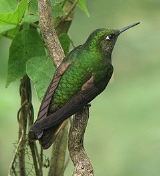
Buff-tailed Coronet
Encyclopedia
Introduction
The Buff-tailed Coronet, Boissonneaua flavescens, is a species of hummingbirdHummingbird
Hummingbirds are birds that comprise the family Trochilidae. They are among the smallest of birds, most species measuring in the 7.5–13 cm range. Indeed, the smallest extant bird species is a hummingbird, the 5-cm Bee Hummingbird. They can hover in mid-air by rapidly flapping their wings...
from the family Trochilidea. It is found in Colombia
Colombia
Colombia, officially the Republic of Colombia , is a unitary constitutional republic comprising thirty-two departments. The country is located in northwestern South America, bordered to the east by Venezuela and Brazil; to the south by Ecuador and Peru; to the north by the Caribbean Sea; to the...
,
Ecuador
Ecuador
Ecuador , officially the Republic of Ecuador is a representative democratic republic in South America, bordered by Colombia on the north, Peru on the east and south, and by the Pacific Ocean to the west. It is one of only two countries in South America, along with Chile, that do not have a border...
, and Venezuela
Venezuela
Venezuela , officially called the Bolivarian Republic of Venezuela , is a tropical country on the northern coast of South America. It borders Colombia to the west, Guyana to the east, and Brazil to the south...
.Distinguishing characteristics are the short bill, glittering green coloration, and buffy color under the remiges (flight feathers) and rectrices (tail feathers). Like other hummingbirds, the buff-tailed coronet is often found in mid-level forest to canopy searching for flowers with nectar and some insects. This bird is commonly found from 1500–2400 meters above sea level.
Description
The buff-tailed coronet has only slight sexual dimorphism. The female is scaled with white feathers mostly throughout the chin and throat, and some on the belly. Prominent feather colorations are iridescent green with darker wing tips, and buffy hues under the wing and tail feathers. On the face, there is an obvious white post ocular spot on each side. Puffy white “boots” are present at the thighs, an orange tuft at the shoulder, and a short, dark bill. Average size for a buff-tailed coronet is 13.2-13.5 cm with a bill length of 1.8–2 cm. (Restall)The buff-tailed coronet and Fawn-breasted Brilliant
Fawn-breasted Brilliant
-Introduction:The Fawn-breasted Brilliant, , is a species of hummingbird. It is found in South American countries such as Bolivia, Colombia, Ecuador, and Peru and lives in tropical climates. It has a light brown chest, a dark green back, a white spot behind the eye, and a red spot on the throat...
, Heliodoxa rubinoides, are commonly confused due to the similar posterior colorations. Yet, the Fawn-breasted Brilliant has more buff coloration on its breast and underbelly as the name suggests.

